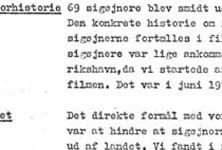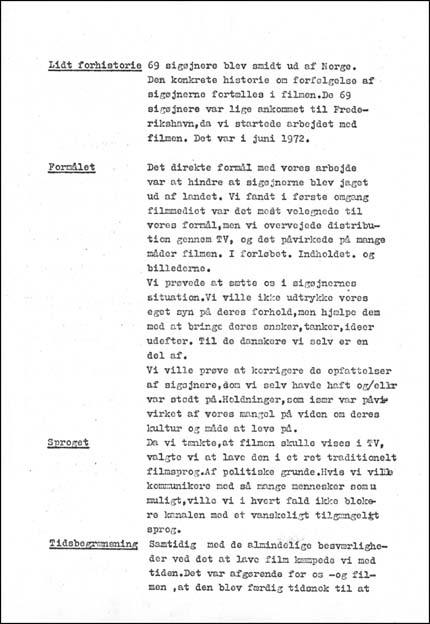  |
Document: Description of the project (1973)
The following document is found in the archive with other papers like sketches, timelines, production considerations, transcripts of interviews, photocopies of articles from newspaper and books, the manuscript for the film. The document is maybe written in 1973 or maybe 1974 and it is unclear for what purpose it has been written and for whom.
The document introduce the 16-mm documentary film, the exhibition, the meeting and the many activities the production group were involved with.

Some history
69 gipsies were thrown out of Norway. This concrete story about persecution of the gipsies is told in the film. The 69 gipsies had just arrived to Frederikshavn when we started producing the film. It was in June 1972.
The purpose
The primary intention with our work was to prevent the gipsies from being thrown out of the country. We first found that film as a medium was suitable for our purpose and we considered the distribution through broadcast television and that influenced the film in many ways. In the process. The content. And the pictures.
We tried to feel empathetic towards the gypsies in their complex situation. We would not express our own view on their circumstance, but help them to bring forward their wishes, thoughts and ideas. To the Danes whom we ourselves are a part of.
We would try to remedy the conceptions of the gypsies that we ourselves had had or had run into. Attitudes that were chiefly influenced by our lack of knowledge about their culture and ways of living.
The language
When we thought that the film should be shown on television, we chose to make it in a rather conventional mode of expression. For political reasons. If we wanted to communicate with as many people as possible we would at any rate not block the channel with an abstruse filmic language.
The time limit
Simultaniouwly with the common difficulties of producing a film we were fighting with time. It was crucial for us – and the film - that is was finished early enough to influence the Danish Minister of Justice, who had the final decision about the destiny of the 69 gipsies.
The film
Here we were working facing two areas. We first tried to arrange a personal showing of the film, but the Minister of Justice K. Axel Nielsen did not have the 20 minutes to see the film. Instead it was seen by the committee in the national parliament (with Meta Ditzel and Kristine Holtberg) who were fighting for the case of the gipsies.
The newspapers
In addition we tried to influence the general public by creating a debate in the newspapers. When the negotiation with television first failed, we produced – to get in contact with more people – an exhibition of photographs and text at the main library in Copenhagen. (It has later been adapted and changed and has been offered to libraries all over the country. Here is has now been distributed in two copies for more than a year.
The National museum of Denmark
In the middle of November the exhibition was moved to the National Museum of Denmark. Here we showed the film for a crowded room (about 500 people) as the introduction to a panel discussion about »What about the Gipsies« [see the poster].
And on november 11, came the finally the decision we had been fighting for: the gipsies were given the permission to stay in Denmark – temporary for only one year.
At the cinema: Kino Valde
The film was still relevant – now more than ever. In December the film was shown in Kino Valde and it became part of the distribution to the libraries together with the exhibition. We travelled around with the film and the exhibition and took part in the debate to the extent that this was possible for us.
Television
On December 30th 1972 the film was shown on television with a short discussion/interview with three of us.
The social workers
When the decision was taken and the municipality was going to take care of the gipsies and their circumstances – we several times meet the social workers who were going to have the daily contact with the gipsies, showing the film and discussing issues of relevance.
The language teacher
Our experiences has also be in teachers favour. They have followed the film and the exhibition incidentally and two from the film team are now active language teachers on local schools.
The gipsies themselves
First of all the film was of course shown for the gipsies themselves – that is almost unnecessary to mention.
Our work process
The film »Amager Common 1972« was made in the Danish Film Institute's Workshop framework. The film group consisted of Jimmy Andreasen, Niels Arild, Bruno Ingemann and Pia Parby.
In the process of recording and editing the film we were all been working to pay our bills. Through the process is was important for us to work as a very close team. Everyone was shooting. Everyone made sound. Everyone had influence at the editing table. The mixing. In many ways a demanding form of working – but also very rewarding. We think we had reached our goal: to use the film as a political tool. And at the same time it was an applied film that pointed out of the actual situation.
|
|
|

